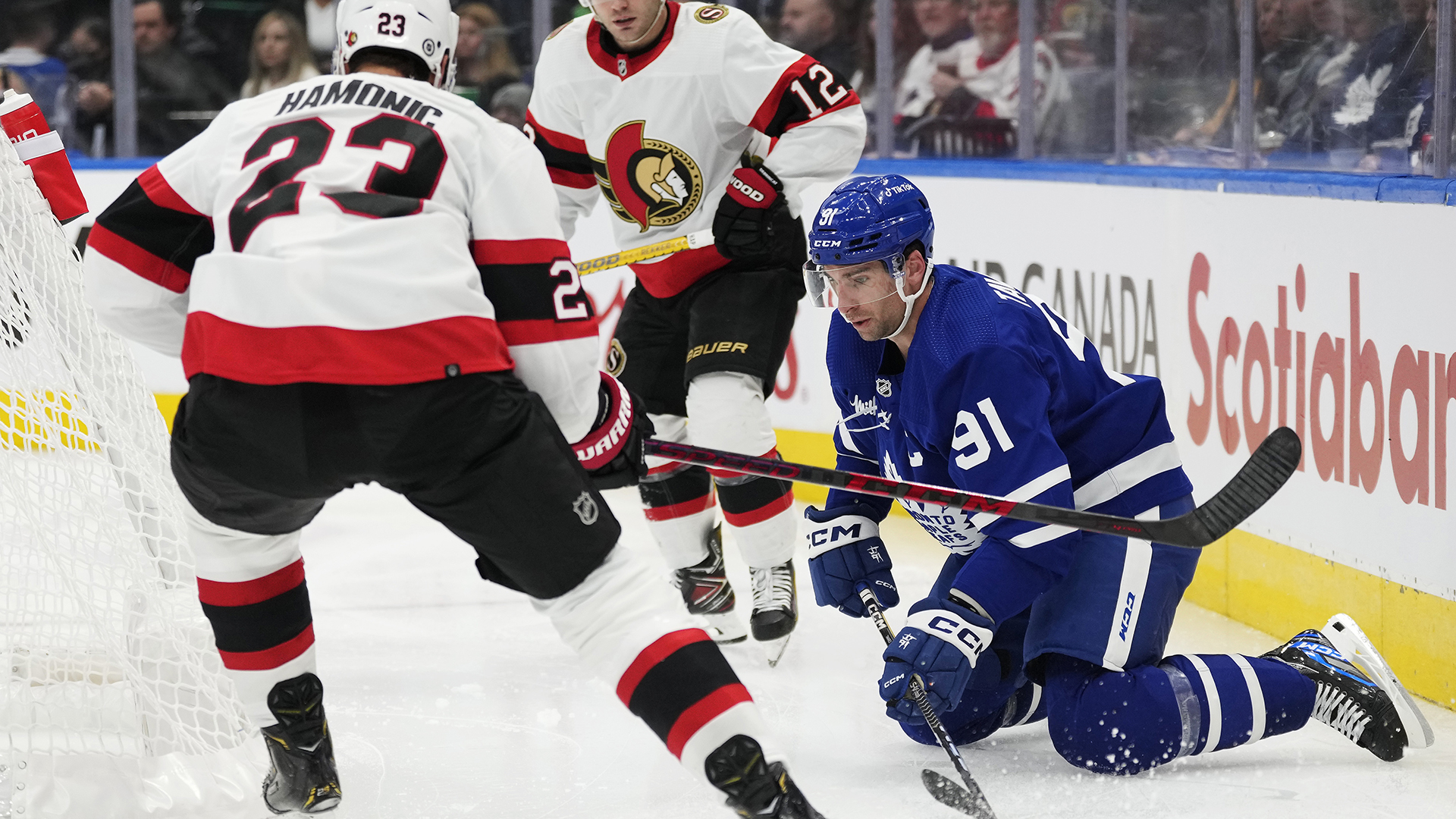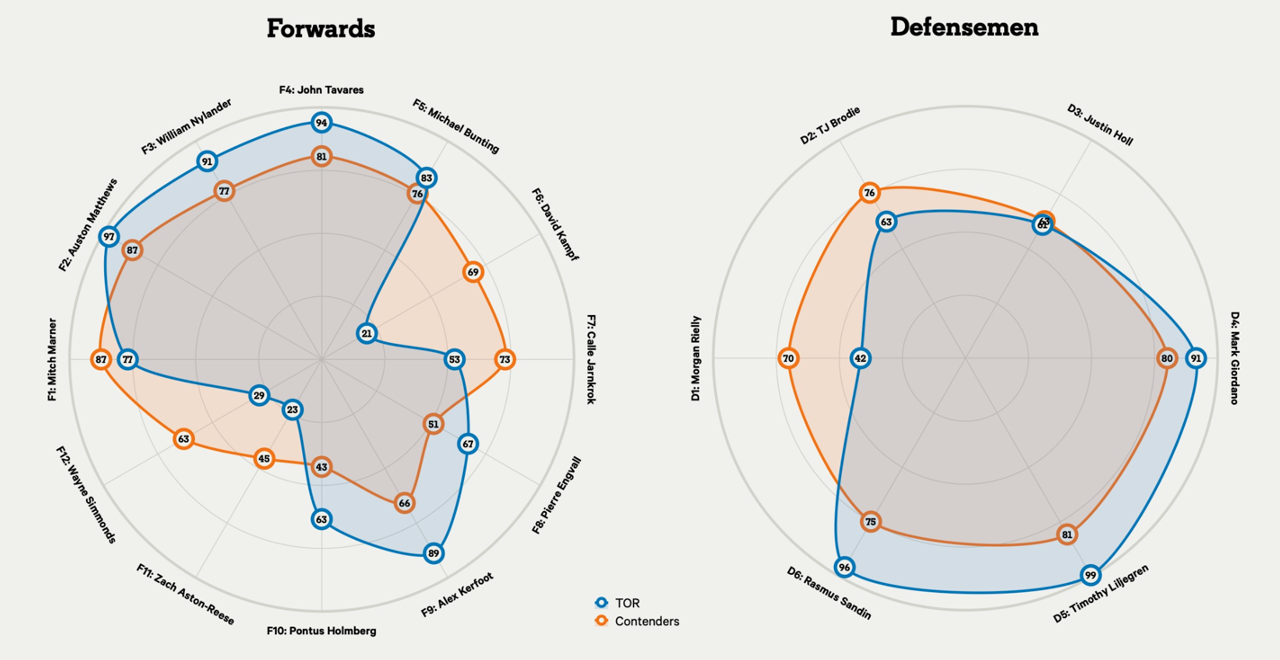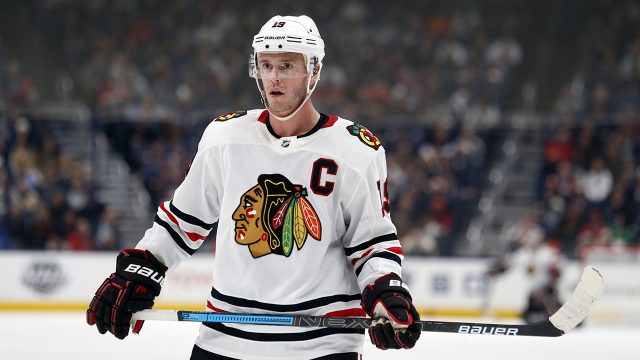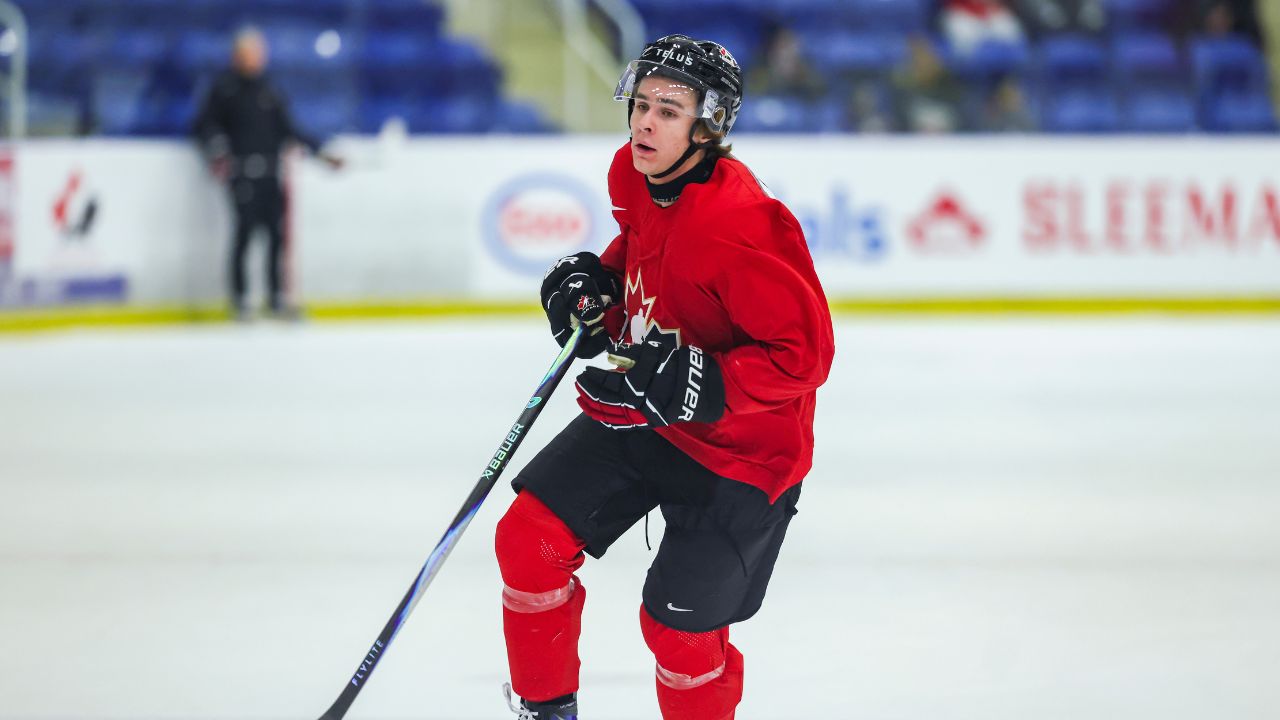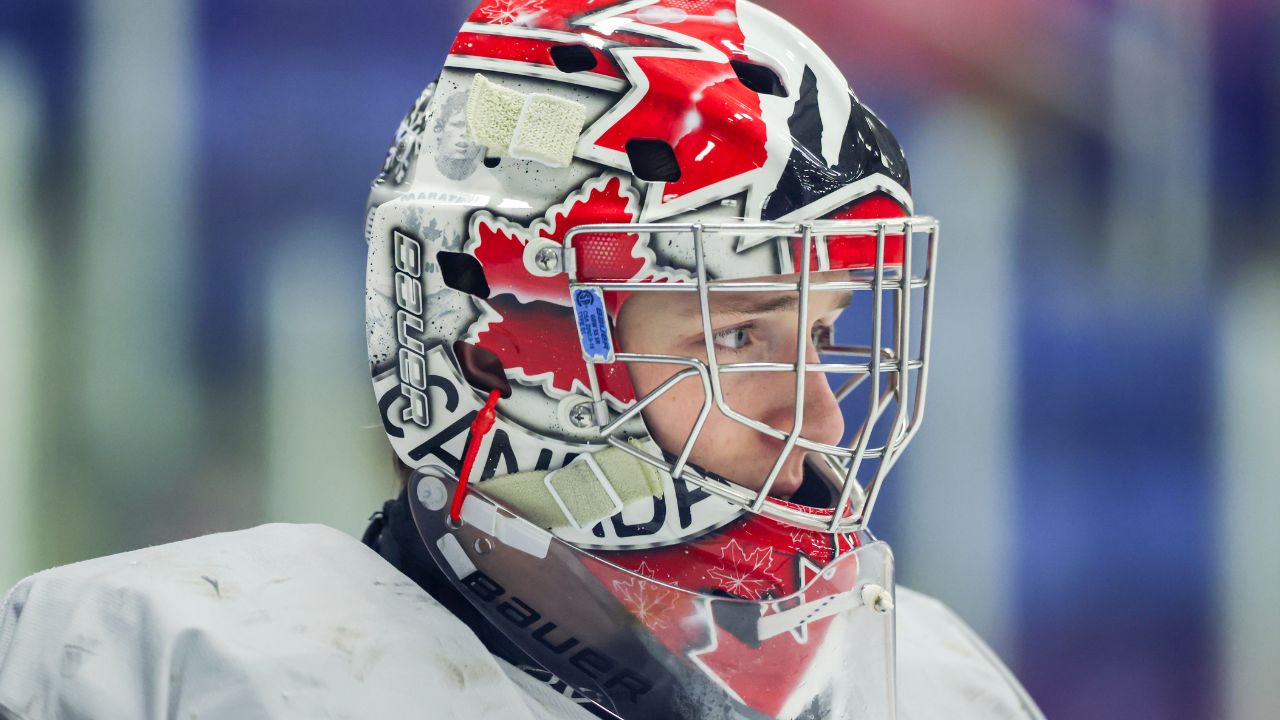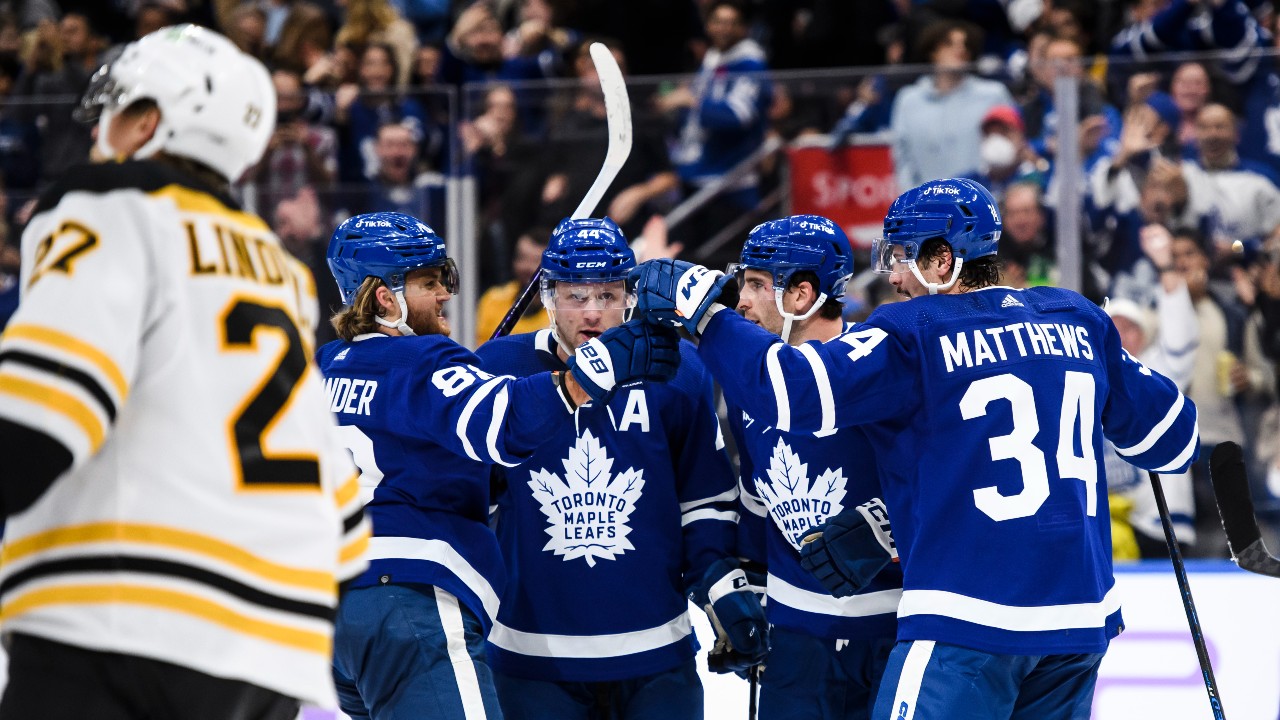
On every NHL team regular players take turns going hot and cold, while fans mostly forget the larger body of that player’s work when discussing them. For stretches of time the hot players become “good” players, while the cold players are “bad.”
Even as an analyst it can be tough to keep the whole season’s context in the frame, and to accurately extrapolate a player’s full resume and compare it to what “average” looks like around the NHL.
This week Dom Luszczyszyn of The Athletic wrote a great post on the Seattle Kraken which addressed that issue in a way I find fascinating. It visualized how the Kraken may in fact be weak in the top-six, but their bottom-six are light years better than most other teams. First I’ll explain how to make sense of the graph, then show you the Kraken’s, and then we’ll talk about the Leafs.
What you need to know to understand the graph:
• F1, F2, and all the way around the circle are the 12 most-used forwards on a given team based on ice time. Same goes for D one-through-six.
• Dom uses his game score metric for each player (a combination of goals and assists and other useful stats), and the farther to the outside of the graph a dot is, the higher that player ranks league-wide (by percentile).
• For comparison’s sake, he plotted out the average rank of each F1, F2 and so on from the contending teams (which are the eight he has with more than a five per cent chance to win the Cup) listed in orange. So for context, the forward who plays the most on each of the contending teams is in the 87th percentile of all forwards by game score.
TO SIMPLIFY: Dot near outside good, dot near inside bad. Orange is average among the contending teams, blue is the team we’re talking about.
Here is the Kraken’s chart, which shows their bottom-six dominance:
A unique visual to confirm something that makes sense, doesn’t it? If you get every team’s eighth-best player (expansion draft), you’ll be weak at the top and strong on the bottom.
Now on to the Maple Leafs, who have Mitch Marner logging the most time on ice for them among forwards, and Wayne Simmonds in the 12th forward slot (which is unlikely come playoffs).
The Leafs are very, very, very good through their top-five forwards. Through the top-three forwards Matthews and Marner are equal or better than the contending teams (which does include Edmonton, as well as Colorado, Tampa Bay, Boston, etc.), and they run away with it in the next few spots. William Nylander, John Tavares and even Michael Bunting show a sizeable advantage at a position that I think is most crucial (since the best players usually find their way through in the playoffs eventually).
For the Leafs, the drop off is staggering at their sixth forward. David Kampf is a great, useful player, and this isn’t entirely fair to him, as listing him as F6 is purely ice time-based (we know he’s a bottom-six guy). Typically that hole has been a rotating cast of “Oh for the love of god please someone take this spot.” It wasn’t Nick Ritchie last year, it wasn’t Nick Robertson this year, and it isn’t Denis Malgin or Alex Kerfoot or Calle Jarnkrok. The Leafs’ F6 is really … nobody. It’s impossible to look at this graph and not recognize a hole the Leafs need to fill by the trade deadline.
From there, the Leafs are really strong. Their third line (namely the F8/F9/F10 spots) has been a big boost this season. And you can see the struggle for fourth line success that has been a work in progress. But as more ice time accumulates, you have to wonder if Pontus Holmberg and Bobby McMann can change the look of Toronto’s bottom-six in an extremely positive way – both have played like found money, and I bet will graph out more favourably with time.
Here’s a similar chart on the Leafs, but it’s wins added or lost (above replacement-level players). Keep in mind, this is just this year, in which Morgan Rielly hasn’t produced nearly like he typically has, so it may look worse than it really is. Or … maybe it’s just reflective of reality.
You can reference the first Leafs graph shown above for the same conclusion: the Leafs are considerably weaker at the top of their defence corps than they are at the bottom. The concern for me is, the spot where the Leafs see massive gains – with Timothy Liljegren and Rasmus Sandin – are partially where you have concern about “playoff style hockey,” and experience and physicality. Those two have had tremendous seasons and are really good NHLers. It’s just the idea that the Leafs have no more seasons of learning curves and “teachable moments” to give, and so Sandin and Liljegren will need to be as good as they’ve shown in the regular season when the temperature gets turned up.
But the more pressing issue here is the plainly obvious top pair conundrum. Every team the Leafs may see in the post-season, particularly coming out of the Atlantic, has one or two elite defenders. Victor Hedman and Mikhail Sergachev await in round one on the Lightning. Charlie McAvoy and Hampus Lindholm are in Boston. The Rangers have Adam Fox, the Hurricanes have Jaccob Slavin, the Devils have Dougie Hamilton. Peak Morgan Rielly garnered a few Norris Trophy votes and at any point may fall somewhere in the range of the 15th-40th best D-man in the league. But the closer he gets to 15th and farther he gets from 40th the better the Leafs’ playoff chances are. You’d absolutely love him as your second-best defenceman.
And so the question has to come up: how pressing is it that the Leafs pursue someone like Jakob Chychrun, who’s having an excellent year in Arizona? How much do you want one more defenceman somewhere else on that graph to give the team a little extra depth, or options, if the D-corps starts struggling? (Because if Rielly isn’t going to win the D1 vs. D1 battle in a series, you better be good everywhere else.)
To me these graphs are a fascinating illustration of the Leafs need, which leads me to a couple conclusions:
One is that this team can win as currently constructed, with elite high-end forwards and solid middle depth players up front. They have an overall solid D-corps of six and their goaltending has been good.
They’re a good team.
But something we’ve always suspected is so visually accessible here. Adding a middle F5-F8 forward is not just important for the Leafs, it’s crucial. The first step is to decide what they want to do, and the next step is to go out there and see what they can do, based on what’s available.
Fans should be encouraged. The Leafs are solid and can be greatly helped by plugging one hole in particular at forward, then figuring out just how crazy they want to get elsewhere (another forward? A top-end D?) .
The bones of a winner are there; now we’ll wait and see just how much meat they want to add to the frame.


